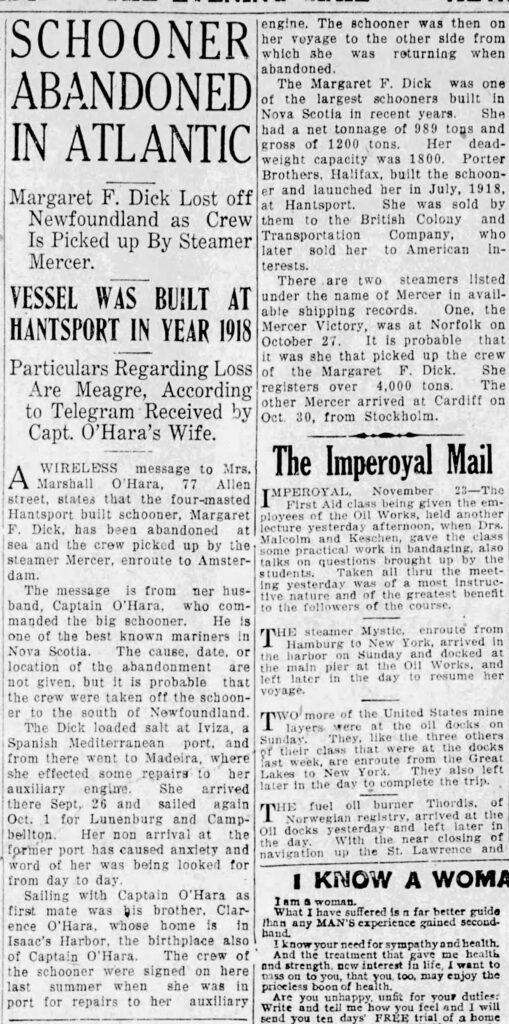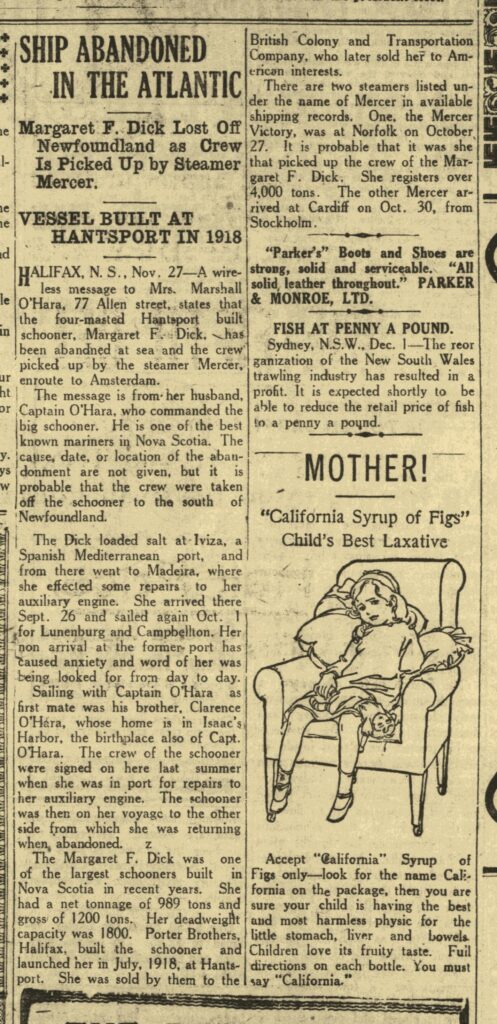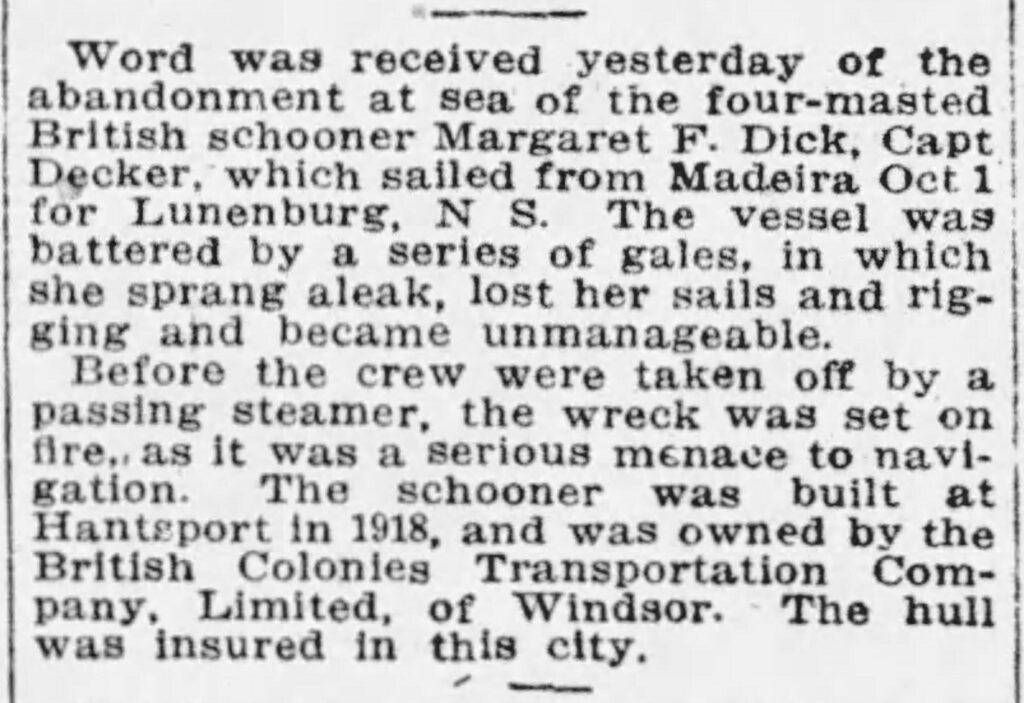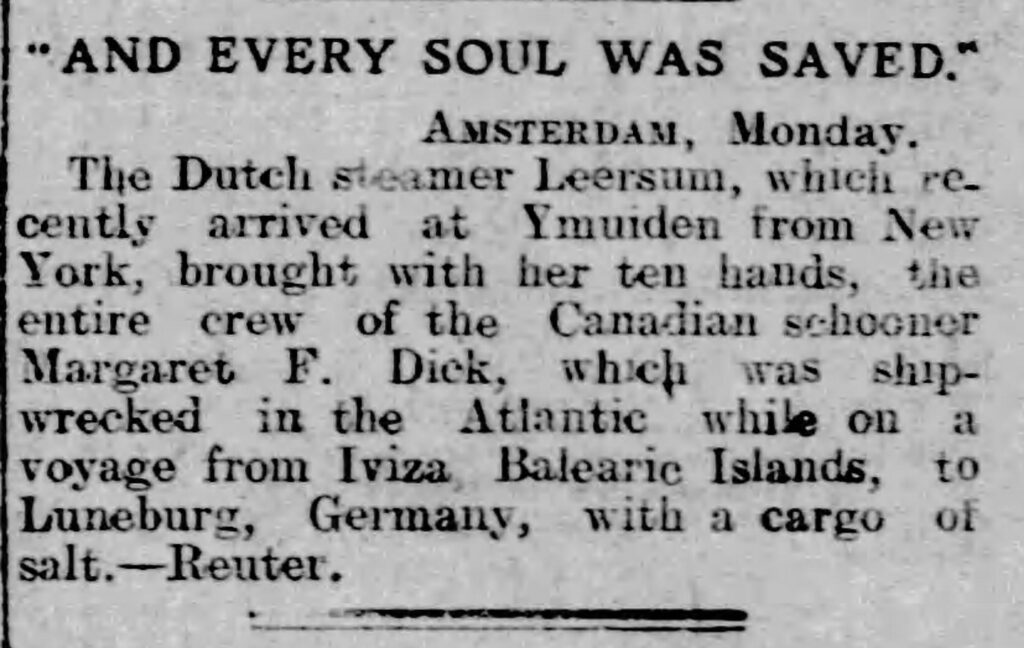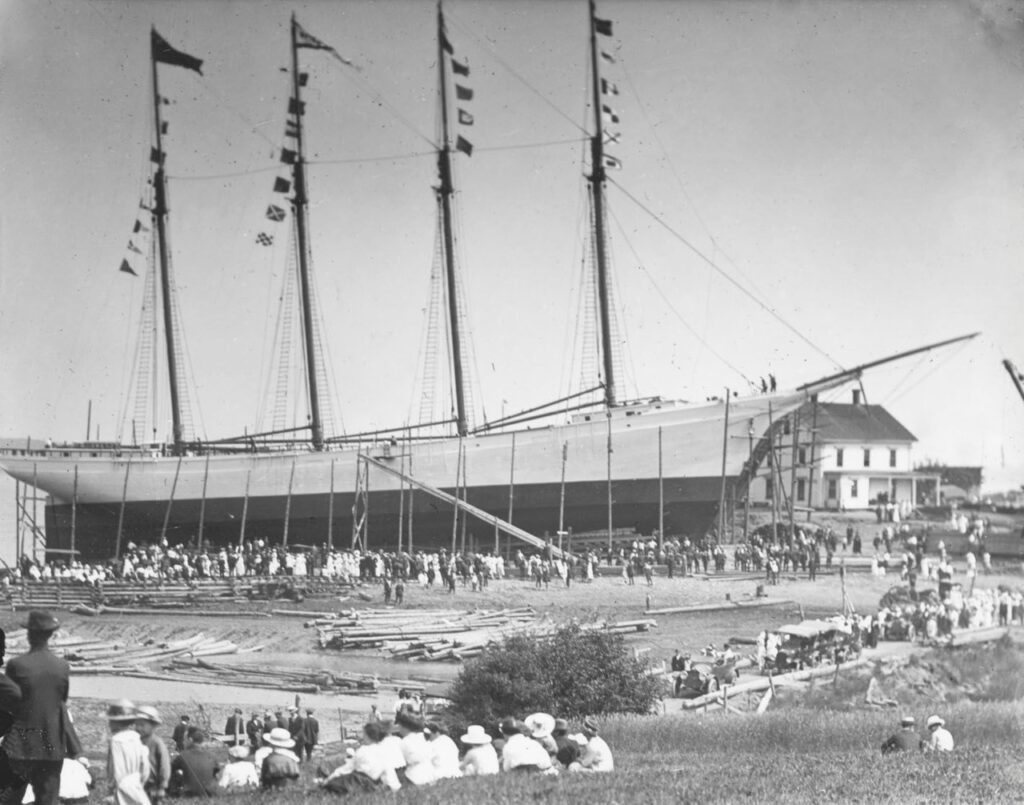


(Special staff correspondence of The Halifax Herald.)
HANTSPORT-ON-AVON. August 25.—While a burnished brass sun burned the pitch pine from her new decks, and caused her white sides to glisten with reflected rays like searchlights thrown upon an ice-berg, the 1,000 ton four-masted schooner Margaret F. Dick slipped smoothly down her tallow coated ways, at the North Shipyards here yesterday afternoon, and nestled into the turbid tidal waters of the Avon silently, smoothly, and naturally as a swooping swallow takes the air. Three thousand people viewed the spectacle lined along the natural amphitheatre which backs the North yards in a sloping hillside which rises to the sky-line, scattered at various points of vantage inside the yards themselves, and watching the launching from the crowded decks of smaller sail and power craft which had gathered from every public and private landing stage on the Avon within a twenty mile radius. And the unanimous opinion was that Saturday’s ceremonial was “the finest launchin’ ever Hantsport did see,” an opinion which was advanced alike by the veterans of the good old days when the Hantsport clipper was known on every sea, and by the enthusiastic youth of the sleepy town, whose expert wisdom on the subject of “lanchin’’’ has been garnered during their years of adolescence solely thru the medium of the yarns the old timers tell.

A MORE completely auspicious occasion could not have been devised by the most benevolent of providences. Out of a misty morning there came a noontide of brilliant sunshine, tempered as the hour of high time approached by a fresh and stimulating breeze blowing briskly in from sea. The tide was high at approximately 2.30, and sharp at that hour the gang of skilled workers whose especial care and pride the Margaret F. Dick has been since November last when her keel was laid, began their task of easing her onto the ways which should carry her to the tumbling waves which are her birthright. For half an hour the crisp sound of the mallets of the shipyard workers striking away the bonds which restrained her surrounded the schooner as the melody of the wedding march envelops the bride. At three o’clock almost to the second the great ship began to move. Her trip to the water was short. She was steeply pitched upon her ways, and inside thirty seconds from the moment when the little group of privileged persons on her deck first thrilled to the sensation of her movement toward the water, she was riding free and easy toward the tugs which waited to restrain her. There was no slip, no mishap and no hitch whatever. It was indeed, a perfect “lanchin’ ”.
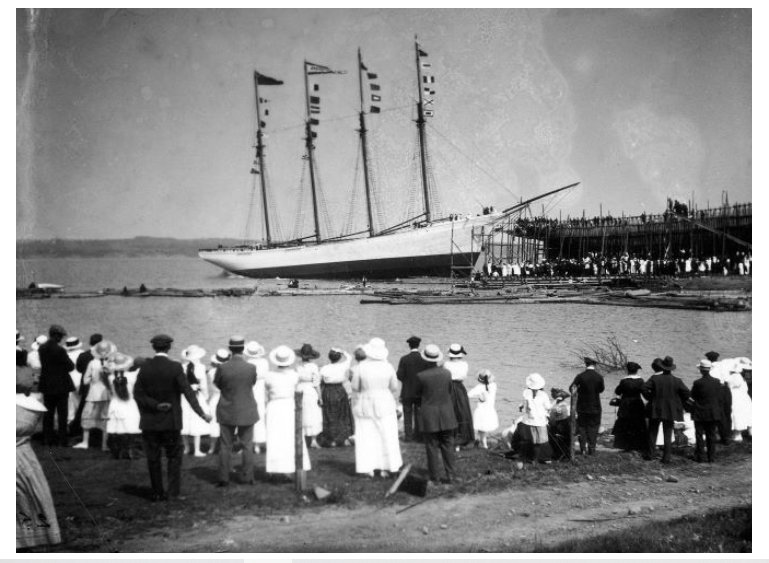

THERE is a special significance, twofold, about the launching of this magnificent vessel from the Hantsport yards. Her safe delivery to the bosom of the ocean is at once a definite and well placed thrust at the throat of the Prussians of Potsdam, and a distinct valuable achievement in the progress of Nova Scotia’s once pre-eminent ship-building industry toward its renaissance. The Margaret F. Dick will sail the high seas in proud defiance of the pirate’s edict of the German U-boat, now so insolently displayed before our eyes. But the war is even now approaching its end and the day and doom of the U-boat are equally sealed. And long after von Triptis and all his slimy crew of sea rats have been forgotten by civilization Nova Scotia ships such as the Margaret F. Dick will sail the seas carrying the diverse products of the East into the teeming ports of the Western hemisphere and returning laden with the merchandise of the West with which to fill the Eastern markets.
Not since the last century has such a ship as the Margaret F. Dick been launched from a Hantsport shipyard. Yet there was a period when the fame of the Hantsport clipper was heard in every port from Singapore to Bergen, and from Halifax to Archangel. These square rigged sturdy, fast sailing and splendidly seaworthy ships which were regularly slipped into the same muddy waters of the Avon which on Saturday so gallantly floated this significant beginning of a new era in Hantsport shipbuilding, was world-wide. Wherever there were ships there was the Hantsport mark, a mark of honest workmanship and skilful building, respected and valued wherever ships might sail.

BUT splendid as were her achievements of the past, there came a time when the universal demand for steel ships brought a blight upon Hantsport’s only industry of note. Wooden vessels were discarded as they succumbed to the ravages of time and the strains of stalwart battling with all the winds of the world. Some were scrapped before their time, engulfed by the various superiorities, real or imagined, which the steel ship presented against them. Hantsport has no steel; she cannot build steel ships, even if she would follow the modern trend; and wooden ships were no longer desired, even when built with all the skill and integrity of a Hantsport yard. The industry dwindled, and Hantsport relapsed from a busy ship-building centre employing hundreds of skilled workers to a little village of barely a thousand souls, set upon a Fundy tidal river, which indeed is half mud for half the time. And then, the war. And with the war, the old things are made new. Once more do barbarians poison wells and maltreat women, and torture children. Once more do soldiers go into battle armed with hand grenade and bludgeon, and wearing armor of steel to protect their most vulnerable points. And once more are there pirates and buccaneers abroad on the high seas; altho indeed the pirates of 1918 are by no means the desperately brave and romantic heroes of the Spanish Main, but sneaking, snaky, loathsome serpents of the sea who strike in the dark, and chose, not the enemy who may show fight, but by preference the unarmed hospital ship with its freight of gentle women and wounded soldiers. Nevertheless the pirates have some success with their carefully chosen prey; and the swagger steel ship which has so proudly pushed aside the honest plebeianism of its wooden parents is now in sore trouble. Sinkings has multiplied, ships have not until lately multiplied on an equal ratio. There is a bigger demands for ships than ever before, ships of any kind, steel if possible, wood at any rate; even ships of concrete are being built. And so comes Hantsport once more into her own.

The Margaret F. Dick therefore, personifies more than merely a well found stalwart schooner of Nova Scotia build. She typifies also the renaissance of the Nova Scotia shipbuilding industry. Where our ships have sailed, they will sail again; and the Margaret F. Dick is one of the vanguard of a vast fleet of similar boats which will in time spread the fame of the Nova Scotia schooner even as the fame of the Nova Scotia clipper formerly went abroad over all the world. There was something of this in the atmosphere of Hantsport on Saturday, and it was with this idea variously formulated, in mind that the thousands of Hantsporters, and residents of the surrounding countryside journeyed to the North yards to witness the launching. The last ship of any size which was launched from these yards was set afloat in 1895. Not for twenty-three years has Hantsport witnessed a launching of any craft more consequential than an occasional small power boat, or pleasure sailing craft, built to gratify a rich man’s whim. Here was an old-time ‘‘Lanchin’’’, the significant and beautiful ceremony which sets another ship upon the bosom of the waters to sail the high seas; and the re-birth of a stately and splendid industry, hoary with the best tradition of the history of the province. Indeed, it was no ordinary occasion.

The mark of modernity and the touch of war was upon this ceremony also. Where in former days the spectators gathered from miles around in buggies. and on foot, here on Saturday they came in flocks of automobiles. It was the first time in the history of Hantsport that there were more automobiles than horse drawn vehicles at a launching. From the humble flivver to the aristocratic twelve cylinder car they were parked in the fields upon both sides of the dusty primitive highway. And the ladies of the Red Cross made up and sold a ‘‘lunch,’’ which, if the question should be asked was some lunch! Modernity and the war; and a wooden four-master being launched from Hantsport! It’s a topsy-turvey world.
Question not that the Margaret F. Dick is a worthy vessel to uphold the best traditions of Nova Scotia shipyards. Built by Fauquier and Porter, in the yards where for half a century the firm of North, father and son, have turned out ships which ranked with the best the world could produce, the schooner has a deadweight capacity of 2,000 tons gross. She is the largest schooner yet turned out of a Nova Scotia yard since the revival of the wooden shipping industry. Her frames are of black birch and Bay Shore spruce, the timbers which have made Nova Scotia wooden ships famous all the world over in the past, and will do so again. Her beams are of British Columbia fir, and the forests of the Pacific coast have contributed their quota also to the making of her keelsons which are of Oregon pine. Her masts, measuring 96 feet in height are also of Oregon pine. Her stem and stern posts are of fir, and her planking is also fir, from British Columbia. Eastern and Western Canada, as well as the United States have contributed to her building. She is truly an allied ship.

The schooner is named for Mrs. Margaret F. Dick, the wife of Charles Dick, who is part owner and manager of the British Columbia Transportation Co., Limited, of Toronto, which firm purchased the vessel as she lay on the stocks last June. Mrs. Dick was an interested spectator, with her husband and their two children, and Mrs. Dick’s sister at the ceremony on Saturday. A. W. Newcombe is the master builder whose skill and genius is so well represented in the ship. Associated with Mr. Newcombe, and in direct charge of the launching ceremonies was D. E. North, consultant builder, who is now the head of the North shipyards firm. Mr. North, with his father has been associated with the building of wooden ships in Hantsport for fifty years, and he was firmly convinced that no better boat ever left the North yard than the ship which floated on Saturday.
The keel of the Margaret F. Dick was laid on the 10th of November, 1917, so that as she slipped into the water she represented nine months and two weeks of expert labor on the part of a group of men which has numbered from 75 to 120 at different periods of construction. She will carry, in addition to her sailing rig two one hundred horse power auxiliary Fairbanks Morse oil engines, and is equipped with twin screws. Her estimated speed under sail is ten knots an hour, and she will ship a crew of fourteen.

Captain C. E. DAGWELL, who has had many years of experience as master of various vessels, mainly of Nova Scotia production will be her skipper. Captain Dagwell who was in command of the ill-fated Dornfontine when she encountered a German submarine off the Nova Scotia coast a few days ago was on the deck of the Margaret F. Dick on Saturday when she took the water, and expressed himself as thoroly (sic) satisfied with his new command. ‘‘As fine a boat as a man would want to see on any ocean,’’ he declared.
The new schooner measures 224 feet over all and has a breadth of 39 feet 6 inches. She is 18 feet 6 inches deep, with a double deck, and a roomy hold adapted to the stowing of any kind of cargo which may offer. The quarters, aft, provide cabin accommodation for the master, mates, chief engineer, with a spare room as an owner’s cabin all finished in British Columbia fir and Oregon pine. Her equipment is almost luxurious for a vessel of her class, and includes an enamelled bath tub which would not disgrace the finest passenger liner which wears camouflage. Complete and ready for sailing her cost is estimated at $250,000.

To Mrs. R. Fred Porter, of Halifax, wife of the general manager of the building firm, fell the honor of christening the new ship, and as with her full code of signal flags flying from her four masts, and her red and white burgee proudly flaunting her name, the boat first began her journey to the water. Mrs. Porter surrounded by a group of Halifax friends and instructed by her hushand, who was perhaps the most frankly enthusiastic human being on board, grasped the quart bottle of Mumm, Extra Dry, with which the christening ceremony was performed, firmly by the neck and proceeded to perform the baptismal rites. It is probable that Mrs. Porter is not in the habit of breaking champagne bottles over ship’s sides; at any rate is was necessary for her to swing the bottle four times before she finally developed sufficiently punch to break the glass; but the thing was done at last, and as the gallant ship floated into the open water on her even keel, the champagne which trickled in joyous and iridescent bubbles down the ship’s side to mingle with the muddy water below testified that the Margaret F. Dick was duly and properly and auspiciously launched.
Once afloat the schooner was taken by tugs to the Hantsport wharf where she tied up for finishing and equipment. When completed she will be placed in the South African trade by her owners, sailing between St. John, N.B., and the Cape.
Source: “The Evening Mail”, Monday August 26, 1918

Epilogue: The Margaret F. Dick was lost at sea in November 1920 south of Newfoundland on a voyage carrying salt from Spain to Lunenburg, Nova Scotia. She suffering major damage from gales and began sinking. All the crew were rescued as per the following newspaper accounts and the ship was set on fire to prevent the wreck from becoming a navigational hazard.

